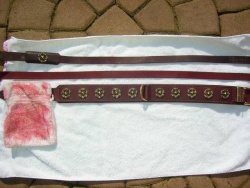Difference between revisions of "Latigo leather"
(Created page with "<p align=center> 300px </p> Latigo leather is cowhide leather that is combination tanned. First it is chrome tanned, then it is vegetable tan...") |
(No difference)
|
Revision as of 20:57, 17 December 2016
Latigo leather is cowhide leather that is combination tanned. First it is chrome tanned, then it is vegetable tanned.[1] Before modern combination tanning, latigo had been combination tanned with alum and gambier.
Latigo is usually infused with oils and waxes. Techniques such as hot-stuffing, wet-stuffing, and fat liquoring have been devised to increase the amount of oil and wax the hide can hold.[2] Due to oil/wax infusion, and its partial chrome tanning, the leather is moderately flexible, less rigid than full vegetable tans, but more rigid than full chrome tans. Because of its weight and tanning process, latigo is among the most expensive cattle hide leathers.[3]
In Western saddlery latigos are the name given to straps securing the cinches to the saddle rigging. They are named for the latigo leather used to create them. They are traditionally manufactured in burgundy.
Latigo is frequently manufactured in weights of 8-12oz, appropriate for use in belts and straps for bags and cases. Lighter latigos in the 3-7oz range are also manufactured, although in smaller quantities.[citation needed] Much Latigo is manufactured in black, or various hues of brown and red. However, latigos in brighter colors are also available, white included.[4] Bright colors are achieved by bleaching the hide prior to dying, and by applying pigment to the surface of the hide.
Latigoleder (von span. látigo = die Peitsche) ist ein festes, strapazierfähiges und offenporiges Rindsleder aus dem Narbenspalt, das in der Praxis vor allem im Outdoor- und Reitsportbereich anzutreffen ist. Dort dient es zum Beispiel als Material für Sattelsitze und -gurte. Es kann vegetabil oder auch chromgegerbt sein und zeichnet sich dadurch aus, dass es nach dem Gerbprozess und dem Färben geölt wird. Dadurch gewinnt es einen weichen Griff, weshalb Latigoleder auch für Hundeleinen und -halsbänder beliebt ist.
Der Nachteil von Latigoleder ist, dass es zu Abfärbungen auf Bekleidung, Haut, Hundefellen etc. kommen kann (Bild), da die Farbe manchmal nicht abriebfest ist. Das kann man aber leicht testen. Einen weißen Lappen anfeuchten und zehnmal über das Leder reiben. Fest, aber nicht mit Gewalt. Je nach Verfärbung des Lappens ergibt sich die Empfindlichkeit.
Abfärbungen durch Reibung bei einem Hundehalsband aus Latigoleder.
Weitere Informationen









 a kotori web solution
a kotori web solution